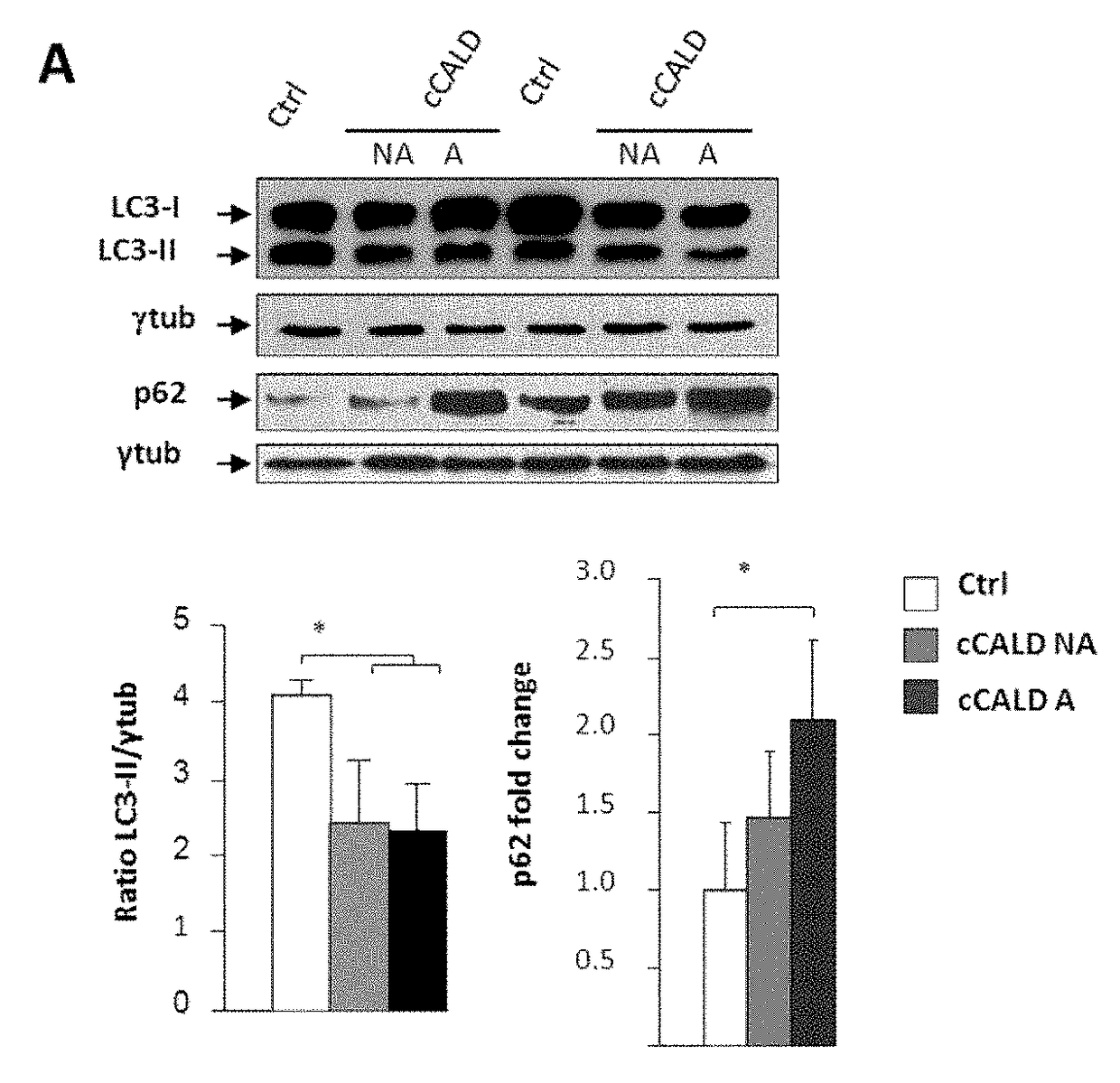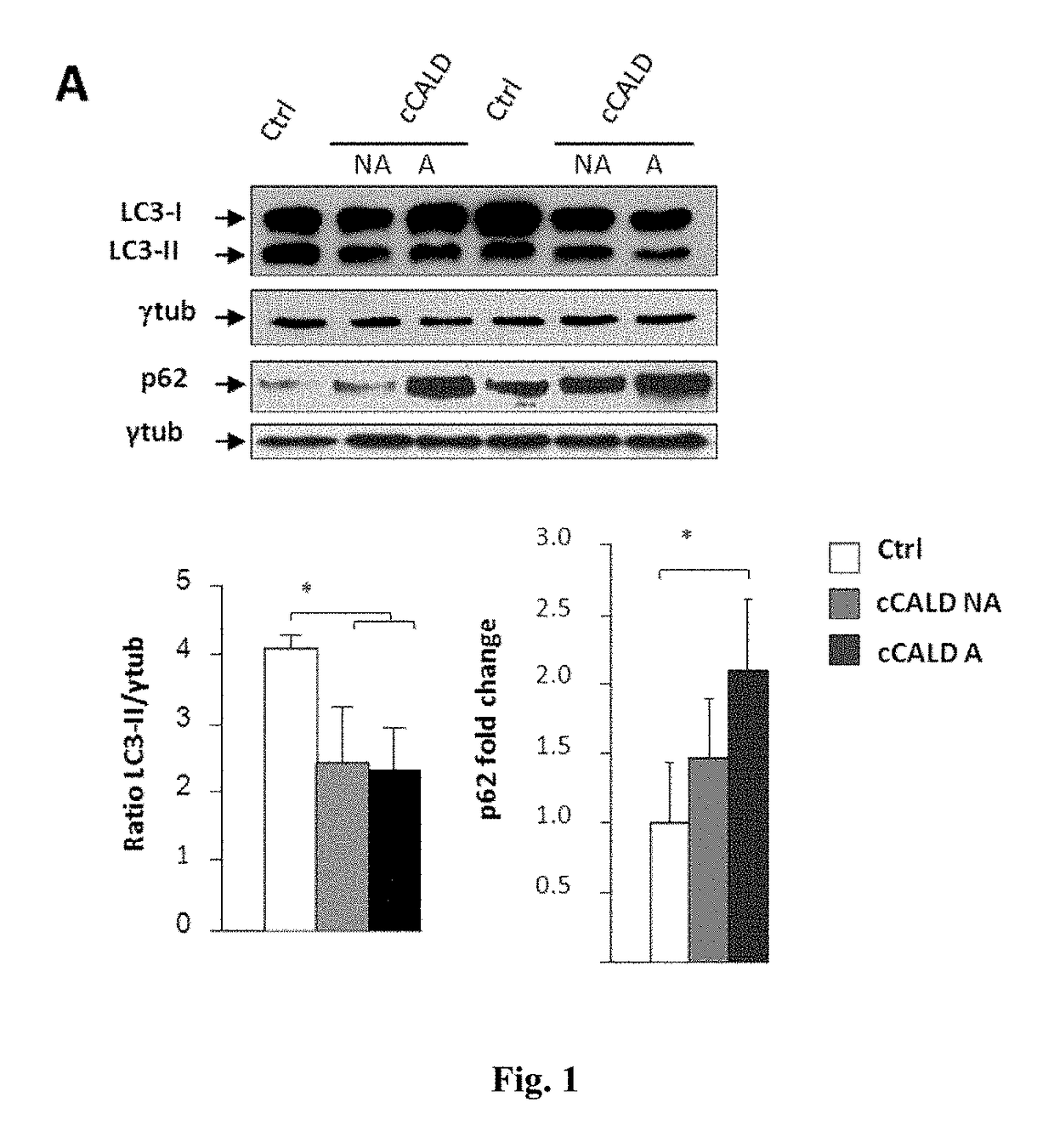Specific mtor inhibitors in the treatment of x-linked adrenoleukodystrophy
a technology of x-linked adrenoleukodystrophy and specific mtor inhibitors, which is applied in the direction of drug compositions, biochemistry apparatus and processes, and metabolic disorders, etc., can solve the problems of elevated mortality risk, limited success of said treatment, and several limitations
- Summary
- Abstract
- Description
- Claims
- Application Information
AI Technical Summary
Benefits of technology
Problems solved by technology
Method used
Image
Examples
example 1
is Impaired in X-ALD Patients and in X-ALD Mouse Models
[0185]The expression patterns of two molecular indicators of autophagy in patients who suffered the cerebral forms of X-ALD, cCALD and AMN were examined. During activation of macroautophagy, the cytosolic protein LC3-I is converted by lipidation into LC3-1 and associates specifically to both sides of the limiting membranes that form the autophagosome. LC3-II does not bind other organelles and is degraded in an autophagy-dependent fashion in lysosomes. When the levels of LC3-II in non-affected and affected brain areas from cCALD and cAMN patients and in control samples were assessed (FIGS. 1A and B), they were consistently lower in both non-affected and affected brain areas of patients. Since without lysosomal inhibitors LC3-II levels depend on the rates of both formation of autophagosomes and conversion into autolysosomes, this decrease may indicate either an autophagy impairment or an increased autophagosome-endosome / lysosome f...
example 2
is Impaired in Fibroblasts from X-ALD Patients
[0188]To assess autophagy in X-ALD fibroblasts, cells were cultured, as previously described (Fuertes G, et al, 2003, Biochem J 375, 75-86), either in serum- and amino acid-free medium (Krebs-Henseleit medium) to stimulate autophagy via the well described starvation response (H: high proteolysis) or in full medium to asses basal autophagy (L: low proteolysis). The results demonstrated that fibroblasts from X-ALD patients had compared to controls increased p62 levels and lower levels of LC3-II, the latter especially in high proteolysis (H) medium (FIG. 3A). As the observed variations in the levels of LC3-II, in FIG. 3A and also in FIG. 1, can be due to a change in synthesis or in degradation of the protein, human fibroblasts were treated with the lysosomal inhibitor bafilomycin A1 to block LC3-II degradation. Under these conditions, the levels of LC3-11 correlate with the number of autophagosomes in the cells. In the presence of bafilomyc...
example 4
airs Autophagy in Human Fibroblasts
[0192]In X-ALD, VLCFA accumulate. The effect of the addition of an excess of hexacosanoic acid to fibroblasts isolated from controls and X-ALD patients was tested. First, the degradation of intracellular proteins was analyzed to determine if it was any alteration in control and X-ALD fibroblasts upon addition of an excess of VLCFA, by analyzing in pulse-chase experiments the degradation of long-lived proteins under starvation. Total protein degradation and also, separately, lysosomal protein degradation were estimated by procedures previously described (Fuertes G, et al, 2003, Biochem J 375, 75-86). As shown in FIG. 5A, total degradation of long-lived proteins is diminished (about 35%) in X-ALD fibroblasts compared to control fibroblasts.
[0193]Similarly, lysosomal degradation, which under these high proteolysis conditions mainly corresponds to macroautophagy (Fuertes G, et al., 2003 Biochem J 375, 75-86), was markedly decreased (about 50%) to reach...
PUM
| Property | Measurement | Unit |
|---|---|---|
| pH | aaaaa | aaaaa |
| thick | aaaaa | aaaaa |
| pH | aaaaa | aaaaa |
Abstract
Description
Claims
Application Information
 Login to View More
Login to View More - R&D
- Intellectual Property
- Life Sciences
- Materials
- Tech Scout
- Unparalleled Data Quality
- Higher Quality Content
- 60% Fewer Hallucinations
Browse by: Latest US Patents, China's latest patents, Technical Efficacy Thesaurus, Application Domain, Technology Topic, Popular Technical Reports.
© 2025 PatSnap. All rights reserved.Legal|Privacy policy|Modern Slavery Act Transparency Statement|Sitemap|About US| Contact US: help@patsnap.com



